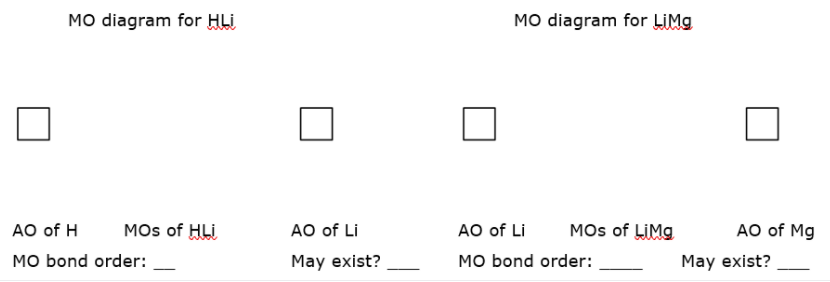Label the valence AOs shown, build from them a molecular orbital diagram for each diatomic particle, label MOs by their type, fill in the valence e s as arrows, calculate the MO bond order, and decide if the diatomic may exist or not : MO diagram for HLi MO diagram for LiMg AO of H MOs of HLi AO of Li AO of Li MOs of LIMg AO of Mg MO bond order: May exist? MO bond order: May exist?
Label the valence AOs shown, build from them a molecular orbital diagram for each diatomic particle, label MOs by their type, fill in the valence e s as arrows, calculate the MO bond order, and decide if the diatomic may exist or not : MO diagram for HLi MO diagram for LiMg AO of H MOs of HLi AO of Li AO of Li MOs of LIMg AO of Mg MO bond order: May exist? MO bond order: May exist?
Chemistry
10th Edition
ISBN:9781305957404
Author:Steven S. Zumdahl, Susan A. Zumdahl, Donald J. DeCoste
Publisher:Steven S. Zumdahl, Susan A. Zumdahl, Donald J. DeCoste
Chapter1: Chemical Foundations
Section: Chapter Questions
Problem 1RQ: Define and explain the differences between the following terms. a. law and theory b. theory and...
Related questions
Question
![### Labeling Valence Atomic Orbitals and Building Molecular Orbital Diagrams
**Objective:**
To understand how to label valence atomic orbitals (AOs) and construct molecular orbital (MO) diagrams for diatomic particles. This exercise involves:
1. Labeling the molecular orbitals by their type.
2. Filling in the valence electrons as arrows.
3. Calculating the MO bond order.
4. Deciding if the diatomic molecule may exist.
**Tasks:**
#### MO Diagram for HLi
- **Boxes:** Represent the molecular orbitals for HLi.
- **Labeling:** Indicate the type of each MO, such as sigma (σ) or pi (π).
- **Filling Electrons:** Use arrows to fill in the valence electrons within the MOs.
- **MO Bond Order:** Calculate based on the formula:
\[
\text{Bond Order} = \frac{(\text{Number of bonding electrons} - \text{Number of antibonding electrons})}{2}
\]
- **Feasibility:** Determine if the diatomic HLi is likely to exist based on the bond order and stability.
#### MO Diagram for LiMg
- **Boxes:** Represent the molecular orbitals for LiMg.
- **Labeling:** Indicate the type of each MO.
- **Filling Electrons:** Fill in the valence electrons with arrows.
- **MO Bond Order:** Calculate as per the formula provided.
- **Feasibility:** Decide if the diatomic LiMg may exist based on the bond order.
**Components:**
- **AO of H:** Atomic orbitals for hydrogen
- **AOs of Li:** Atomic orbitals for lithium
- **AOs of Mg:** Atomic orbitals for magnesium
**Calculations:**
- Record the MO bond order for each diatomic molecule.
- Identify if the molecule may possibly exist.
This exercise aids in visualizing the quantum mechanics behind chemical bonding in diatomic molecules, enhancing comprehension of molecular stability and existence.](/v2/_next/image?url=https%3A%2F%2Fcontent.bartleby.com%2Fqna-images%2Fquestion%2F7e6fe4d9-c522-461f-bc62-94d23fd62501%2F5f963850-d7d1-4390-9690-4101311a79a4%2F7axc156_processed.png&w=3840&q=75)
Transcribed Image Text:### Labeling Valence Atomic Orbitals and Building Molecular Orbital Diagrams
**Objective:**
To understand how to label valence atomic orbitals (AOs) and construct molecular orbital (MO) diagrams for diatomic particles. This exercise involves:
1. Labeling the molecular orbitals by their type.
2. Filling in the valence electrons as arrows.
3. Calculating the MO bond order.
4. Deciding if the diatomic molecule may exist.
**Tasks:**
#### MO Diagram for HLi
- **Boxes:** Represent the molecular orbitals for HLi.
- **Labeling:** Indicate the type of each MO, such as sigma (σ) or pi (π).
- **Filling Electrons:** Use arrows to fill in the valence electrons within the MOs.
- **MO Bond Order:** Calculate based on the formula:
\[
\text{Bond Order} = \frac{(\text{Number of bonding electrons} - \text{Number of antibonding electrons})}{2}
\]
- **Feasibility:** Determine if the diatomic HLi is likely to exist based on the bond order and stability.
#### MO Diagram for LiMg
- **Boxes:** Represent the molecular orbitals for LiMg.
- **Labeling:** Indicate the type of each MO.
- **Filling Electrons:** Fill in the valence electrons with arrows.
- **MO Bond Order:** Calculate as per the formula provided.
- **Feasibility:** Decide if the diatomic LiMg may exist based on the bond order.
**Components:**
- **AO of H:** Atomic orbitals for hydrogen
- **AOs of Li:** Atomic orbitals for lithium
- **AOs of Mg:** Atomic orbitals for magnesium
**Calculations:**
- Record the MO bond order for each diatomic molecule.
- Identify if the molecule may possibly exist.
This exercise aids in visualizing the quantum mechanics behind chemical bonding in diatomic molecules, enhancing comprehension of molecular stability and existence.
Expert Solution
Step 1
The table given is,

Step by step
Solved in 2 steps with 2 images

Recommended textbooks for you

Chemistry
Chemistry
ISBN:
9781305957404
Author:
Steven S. Zumdahl, Susan A. Zumdahl, Donald J. DeCoste
Publisher:
Cengage Learning

Chemistry
Chemistry
ISBN:
9781259911156
Author:
Raymond Chang Dr., Jason Overby Professor
Publisher:
McGraw-Hill Education

Principles of Instrumental Analysis
Chemistry
ISBN:
9781305577213
Author:
Douglas A. Skoog, F. James Holler, Stanley R. Crouch
Publisher:
Cengage Learning

Chemistry
Chemistry
ISBN:
9781305957404
Author:
Steven S. Zumdahl, Susan A. Zumdahl, Donald J. DeCoste
Publisher:
Cengage Learning

Chemistry
Chemistry
ISBN:
9781259911156
Author:
Raymond Chang Dr., Jason Overby Professor
Publisher:
McGraw-Hill Education

Principles of Instrumental Analysis
Chemistry
ISBN:
9781305577213
Author:
Douglas A. Skoog, F. James Holler, Stanley R. Crouch
Publisher:
Cengage Learning

Organic Chemistry
Chemistry
ISBN:
9780078021558
Author:
Janice Gorzynski Smith Dr.
Publisher:
McGraw-Hill Education

Chemistry: Principles and Reactions
Chemistry
ISBN:
9781305079373
Author:
William L. Masterton, Cecile N. Hurley
Publisher:
Cengage Learning

Elementary Principles of Chemical Processes, Bind…
Chemistry
ISBN:
9781118431221
Author:
Richard M. Felder, Ronald W. Rousseau, Lisa G. Bullard
Publisher:
WILEY